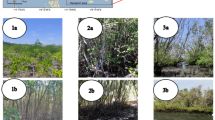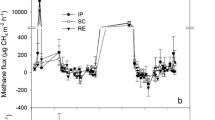Abstract
Fluxes of methane (CH4) and carbon dioxide (CO2) to the atmosphere at 52 sites within a salt marsh were measured by a dark static chamber technique from mid July to mid September. Mean CH4 fluxes ranged from 0.2 mg m−2 d−1 to 11.0 mg m−2 d−1, with an overall average of 1.6 mg m−2 d−1. Flux of CH4 was inversely correlated (r2=0.23, p = 0.001) with salinity of the upper porewater at the site, suggesting the dominant role of SO4 2− in inhibiting methanogenesis in salt-marsh sediments. The combination of salinity and water table position was able to explain only 29% of the variance in CH4 emission. Mean soil flux of CO2 ranged from 0.3 g m−2 d−1 to 3.7 g m−2 d−1, with an overall average of 2.5 g m−2 d−1; it was correlated with aboveground biomass (positive, r2=0.38, p = 0.001) and position of the water table (negative, r2 = 0.55, p = 0.001). The combination of biomass and water table position accounted for 63% of the variance in CO2 flux. There were high variations in gas flux within the six plant communities. The sequences were CH4: upland edge > panne > pool > middle marsh > low marsh > high marsh, and CO2: middle marsh > low marsh > upland edge > high marsh > panne > pool. Compared to other salt-marsh systems, this Bay of Fundy marsh emits small amounts of CH4 and CO2.
Similar content being viewed by others
Literature Cited
Bartlett, K. B., D. S. Bartlett, R. C. Harriss, andD. I. Sebacher. 1987. Methane emissions along a salt marsh salinity gradient.Biogeochemistry 4:183–202.
Bartlett, K. B., R. C. Harriss, andD. I. Sebacher. 1985. Methane flux from coastal salt marshes.Journal of Geophysical Research 90:5710–5720.
Canadian Hydrographic Service. 1993. Canadian Tide and CurrentTables, Vol. 1: Atlantic Coast and Bay of Fundy. Fisheries and Oceans, Ottawa.
Cooper, D. J., W. Z. deMello, W. J. Cooper, R. G. Zika, E. S. Saltzman, J. M. Prospero, and D. L. Savoie. 1987. Short-term variability in biogenic sulfur emissions from a FloridaSpartina alterniflora marsh.Atmospheric Environment 21:7–12.
Craft, C. B., E. D. Seneca, andS. W. Broome. 1991. Loss on ignition and Kjeldahl digestion for estimating organic carbon and total nitrogen in estuarine marsh soils: Calbration with dry combustion.Estuaries 14:175–179.
DeLaune, R., C. Smith, andW. H. Patrick, Jr. 1983. Methane release from Gulf Coast wetlands.Tellus 35B:8–15.
Dunfield, P., R. Knowles, R. Dumont, andT. R. Moore. 1993. Methane production and consumption in temperate and subarctic peat soils: Response to temperature and pH.Soil Biology and Biochemistry 25:321–326.
Gross, M. F., M. A. Hardisky, P. L. Wolf, andV. Klemas. 1991. Relationship between aboveground and belowground biomass ofSpartina alterniflora (smooth cordgrass).Estuaries 14: 180–191.
Holmer, M. andE. Kristensen. 1994. Coexistence of sulfate reduction and methane production in an organic-rich sediment.Marine Ecology Progress Series 107:177–184.
Houghton, R. A. andG. M. Woodwell. 1980. The Flax Pond ecosystem study: Exchanges of CO2 between a salt marsh and the atmosphere.Ecology 61:1434–1445.
Howarth, R. W. 1984. The ecological significance of sulfur in the energy dynamics of salt marsh and coastal marine sediments.Biogeochemistry 1:5–27.
Howes, B. L., J. W. H. Dacey, andJ. M. Teal. 1985. Annual carbon mineralization and belowground production ofSpartina alterniflora in a New England salt marsh.Ecology 66:595–605.
King, G. M. andW. J. Wiebe. 1978. Methane release from soils of a Georgia salt marsh.Geochimicaet Cosmochimica Acta 42:343–348.
Miller, W. R. andF. E. Egler. 1950. Vegetation of the Wequetequock-Pawcatuck tidal marshes, Connecticut.Ecological Monographs 20:143–172.
Moore, T. R., A. Heyes, andN. T. Roulet. 1994. Methane emissions from wetlands, southern Hudson Bay Lowland.Journal of Geophysical Research 99:1455–1467.
Moore, T. R. andM. Dalva. 1993. The influence of temperature and water table position on carbon dioxide and methane emissions from laboratory columns of peatland soils.Journal of Soil Science 44:651–664.
Moore, T. R. andN. T. Roulet. 1991. A comparison of dynamic and static chambers for methane emission measurements from subarctic fens.Atmosphere-Ocean 29:102–109.
Moore, T. R. andN. T. Roulet. 1993. Methane flux∶water table relations in northern wetlands.Geophysical Research Letters 20: 587–590.
Moore, T. R. andN. T. Roulet. 1995. Methane emission from Canadian peatlands, p. 153–164.In R. Lal, J. Kimble, E. Levine, and B. A. Stewart (eds.), Soils and Global Change. Lewis Publishers, Boca Raton, Florida.
Morris, J. T. 1988. Pathways and controls of the carbon cycle in salt marshes, p. 497–510.In K. K. Hook, W. H. McKee, Jr. H. K. Smith, J. Gregory, V. H. Burrell, Jr. M. R. DeVoe, R. E. Sojka, S. Gilbert, R. Banks, L. H. Stolzy, C. Brooks, T. D. Matthews, and T. H. Shear (eds.), The Ecology and Management of Wetlands, Vol. 1: Ecology of Wetlands. Timber Press, Portland, Oregon.
Morris, J. T. andG. J. Whiting. 1985. Gas advection in sediments in a South Carolina salt marsh.Marine Ecology Progress Series 27:187–194.
Morris, J. T. andG. J. Whiting. 1986. Emission of gaseous carbon dioxide from salt-marsh sediments and its relation to other carbon losses.Estuaries 9:9–19.
Nyman, J. A. andR. D. DeLaune. 1991. CO2 emission and soil Eh response to different hydrological conditions in fresh, brackish, and saline marsh soils.Limnology and Oceanography 36:1406–1414.
Prieme, A. 1994. Production and emission of methane in a brackish and a freshwater wetland.Soil Biology and Biochemistry 26:7–18.
Raich, J. andW. H. Schlesinger. 1992. The global carbon dioxide flux in soil respiration and its relation to vegetation and climate.Tellus 44B:81–89.
Redfield, A. C., 1972. Development of a New England salt marsh.Ecological Monographs 42:201–237.
Rouse, W. R., S. Holland, andT. R. Moore. 1995. Variability in methane emissions from wetlands at northern treeline near Churchill, Manitoba, Canada.Arctic and Arctic Research 27:146–156.
Senior, E., B. Lindstrom, B., Ibrahim, andD. Nedwell. 1982. Sulfate reduction and methanogenesis in the sediment of a saltmarsh on the east coast of the United Kingdom.Applied Environmental Microbiology 43:987–996.
Smith, C. J., R. D. DeLaune, andW. H. Patrick, Jr. 1983. Carbon dioxide emission and carbon accumulation in coastal wetlands.Estuarine Coastal and Shelf Science 17:21–29.
Whiting, G. J. andJ. P. Chanton. 1992. Plant-dependent CH4 emission in a subarctic Canadian fen.Global Biogeochemical Cycles 6:225–231.
Whiting, G. J. andJ. P. Chanton. 1993. Primary production control of methane emission from wetlands.Nature 364:794–795.
Author information
Authors and Affiliations
Rights and permissions
About this article
Cite this article
Magenheimer, J.F., Moore, T.R., Chmura, G.L. et al. Methane and carbon dioxide flux from a macrotidal salt marsh, Bay of Fundy, New Brunswick. Estuaries 19, 139–145 (1996). https://doi.org/10.2307/1352658
Received:
Accepted:
Issue Date:
DOI: https://doi.org/10.2307/1352658




